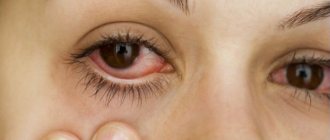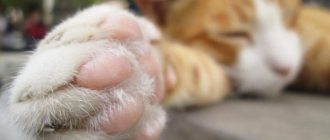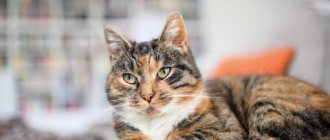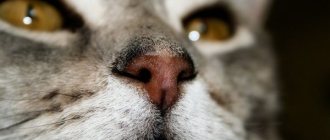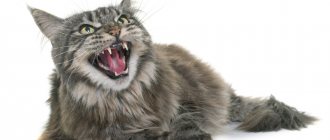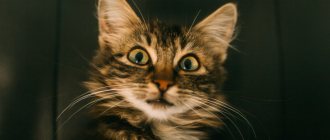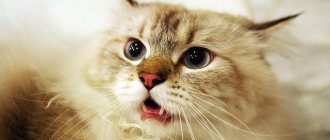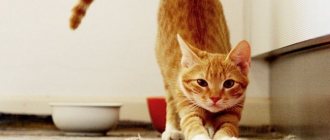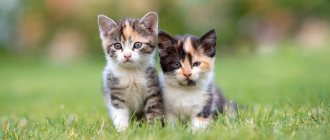Danil Ignatievich Safronov
veterinarian Petstory
When a cat snores or wheezes, owners are often puzzled by the question – is this a problem? Snoring is mostly normal, but in some cases it can indicate health problems. There are a number of pathologies that explain the occurrence of snoring, as well as why a cat sniffles through its nose when it sleeps. The list is quite extensive, so it can be difficult to get to the bottom of the true cause on your own, without a veterinarian.
What causes snoring in cats?
Snoring is the sound produced by vibration of the soft tissues of the upper respiratory tract during sleep. This may be due to the presence of some kind of obstruction to the passage of air into the lungs.
First of all, cat snoring, as a normal phenomenon, may be associated with the physiological characteristics of a particular animal. During deep sleep, the entire body relaxes, including the muscles of the throat and respiratory organs. This causes a narrowing of the airways, which contributes to the vibration of soft tissues due to the incoming air during the next breath.
Sometimes a cat makes sounds when it sleeps if its body is in an unusual, strange sleeping position. Certain positions of the head and body may result in a situation where air flow is restricted, leading to snoring. After changing body position, cat snoring usually stops.
Additionally, there are brachycephalic cat breeds that tend to snore, snore, or snort more due to the structure of their face. Strange sounds may accompany their breathing even while they are awake. This is due to shortening of the facial bones of the skull and nose, shrinkage of the nostrils and narrowing of the nasal passages. The combination of these factors, coupled with an elongated soft palate and adjacent tissue, is more likely to block the airway. If a brachycephalic kitten sniffles through his nose in his sleep, this is normal, because the matter is in the peculiarities of his anatomy. But, of course, if there are no other symptoms.
Brachycephalic breeds include: American Burmese, Persian, Exotic Shorthair, Himalayan, American Shorthair, Devon Rex, Singapura, British, Scottish.
Preventive actions
To prevent the listed diseases, one of the symptoms of which is sniffling and grunting in a pet, the following safety measures must be observed:
- Carry out vaccinations and deworming in a timely manner. Such measures will help avoid the development of infectious diseases and the appearance of parasites.
- If your pet has an allergy, eliminate its sources in the apartment and avoid the cat’s contact with allergens outside the home.
- Avoid overeating. Do not leave uneaten food in the bowl. If you gain excess weight, it is recommended to switch your pet to a low-calorie diet. Sterilized cats and neutered cats must be fed special food.
- Avoid hypothermia and overheating of the pet and drafts.
- Increase the animal’s immunity through the regular use of vitamin and mineral complexes, agreed with the veterinarian.
- Conduct regular preventive veterinary examinations to promptly identify existing diseases.
- Start eliminating signs of pathologies immediately after they are identified.
What kind of snoring happens?
When a cat snores or snores loudly during sleep, the nature of the sounds produced may vary. It all depends on the specific animal, the nature of the problem and the location of the pathology, if, of course, it exists.
There are two main types of abnormal sounds associated with obstructive airway diseases: stertor and stridor. They occur either on inhalation or exhalation, depending on the location and severity of the obstruction.
- Stertor occurs as a result of vibration of soft tissues or the presence of secretions in the upper respiratory tract. When they vibrate, they create a classic low-frequency noise. This is the sound that is called snoring. Most often it occurs due to obstruction of the airways inside the nose or throat.
- Stridor occurs when hard tissue vibrates. The result is the formation of a sharp, high-frequency sound. It may occur due to nasal obstruction. Stridor is most often associated with narrowing of the larynx (eg, due to laryngeal paralysis or tracheal collapse).
Sometimes both types of pathological noises can be accompanied by additional characteristics: the sounds can be dry and wet, crackling, hoarse.
Providing emergency care for a pet
Every cat owner should know the list of warning signs that indicate serious problems with the animal’s health:
- Weak and lethargic appearance.
- Uncontrollable vomiting.
- Dry hacking cough or blood in the sputum.
- Anxious and fearful behavior.
Veterinarians will provide the best care to a sick cat. By trying to cope with the problem on their own, the owners of the furry patient only complicate further treatment. Heart, lung, kidney and brain diseases cannot be treated with traditional methods at home.
In an emergency situation, when the veterinary clinic is far away and you need to act quickly, you can follow the following recommendations:
- A foreign object stuck in the throat can be pulled out with tweezers or your fingers. To do this, the cat opens its mouth wide and looks into its throat. If the object is within sight, you can act.
- An object lodged across the trachea can be shaken out of the animal by grasping the cat by the hind legs and pressing on the diaphragm. If the actions are not successful, you need to urgently take the sufferer to the veterinarian.
- If the owner is sure that poisoning has occurred, before the doctor arrives, the cat should be given a weak solution of potassium permanganate to drink. Gastric lavage is the first aid for poisoning of both animals and people.
Why a cat may snore or wheeze in its sleep - 10 reasons
Physiological features
Occurs in brachycephalic breeds (breeds with shortened nasal passages and an elongated palate), as well as in all breeds during relaxation and unusual body position during sleep (this was written above).
Hurry up, choose a box and find out what gift awaits you
Discount on pet insurance
Promo code copied to clipboard
Elderly age
The muscles around the nose, pharynx and larynx lose tone with age, causing vibrations in these areas to become more intense.
Excess weight
In obese animals, the tissues surrounding the upper respiratory tract exert additional pressure, blocking the passage of air.
Upper respiratory tract infections
They are caused by fungal, viral, bacterial agents and are accompanied by inflammation, swelling of tissues, and accumulation of mucous secretions that interfere with normal breathing and lead to narrowing of the nasal passages.
Foreign objects in the respiratory tract
Animals' natural way of exploring the world through their sense of smell can lead to foreign objects entering the nasal cavity. Pieces of debris, food, plant materials (grass blades) or other objects can become lodged in the nose, causing snoring.
Neoplasms, polyps
They can be either benign or malignant and can partially or completely block the passages in the nasal cavity and larynx.
Asthma, allergies
Both conditions cause inflammation and severe swelling of tissue in the airways and can additionally be complicated by infections of a viral or bacterial nature.
Structural abnormalities of the upper respiratory tract
These include: an elongated palate (it closes the entrance to the trachea); stenosis (narrowing) of the nostrils; nasopharyngeal stenosis (narrowing of the common nasal passage); hypoplastic (narrowed) trachea; inverted laryngeal sacs (impede the passage of air). These pathologies are mainly found in brachycephalics, but are sometimes found in breeds with a normal structure of the skull bones.
Periodontal diseases
These pathologies can lead to an oronasal fistula (hole) between the oral and nasal cavities with profuse purulent, bloody discharge, and tissue swelling, which, in turn, contributes to the appearance of snoring or wheezing.
Climatic conditions
Low air humidity leads to excessive dryness of the mucous membrane of the airways and oral cavity, causing snoring.
How to treat a cold
In the treatment of viral or acute catarrhal rhinitis caused by hypothermia, topical preparations (drops and sprays) are used4:
- Antibacterial and antiviral. They destroy pathogenic microflora and prevent the spread of infection into the auditory and lower respiratory tract.
- Mucolytics. They reduce swelling of the mucous membrane, thin out accumulated mucus and help clear the nose.
- Vasoconstrictors (decongestants). Relieves nasal congestion and eliminates swelling of the mucous membrane. One such drug is Xilong nasal spray. It contains the vasoconstrictor substance xylometazoline and dexpanthenol, which has a regenerating effect. For children from 2 to 6 years old, Xilong Kids spray is provided.
To enhance the therapeutic effect, before using sprays, the nasal passages are washed with aqueous solutions of sea salt.
When is snoring normal?
In general, snoring is considered normal if it occurs only during sleep without changing the animal's behavior and is not accompanied by other symptoms.
The sudden onset of snoring, wheezing or their progression, as well as cases where the cat snores and wheezes while breathing around the clock, may indicate a problem. It is also abnormal to experience additional symptoms: coughing, sneezing, nasal discharge, shortness of breath and other signs.
The video shows an example of normal snoring
Possible diseases and pathologies
When your pet snores constantly, or very often, it may be a symptom of one of the following conditions:
- swelling of the larynx; may be caused by allergies, or the presence of foreign objects in the respiratory system;
- urolithiasis disease; snoring is sometimes accompanied by wheezing;
- the presence of worms, which may even be present in the respiratory system;
- asthma;
- rhinitis;
- pneumonia and bronchitis;
- heart failure; along with wheezing, a cough and blue discoloration of the mucous membranes can be observed;
- respiratory tract infections;
- obesity.
A veterinarian will help the owner determine the cause of wheezing when breathing in a cat.
In what cases should you contact a veterinarian?
An emergency visit to a veterinarian is required by the appearance of symptoms such as shortness of breath, breathing with an open mouth, temporary cessation of breathing (usually during sleep), poor appetite, apathy, and fatigue.
If your cat begins to snore more often or louder than usual and/or other symptoms (coughing, sneezing, discharge from the nose and eyes) appear, this may indicate a worsening condition that requires consultation with a specialist.
Diagnosis of the main causes of snoring will include the following: chest x-ray; clinical and biochemical blood tests; tests for respiratory infections. In some situations (foreign objects, neoplasms, polyps), additional diagnostics are required: endoscopy; computed tomography or magnetic resonance imaging of the head, cytological and histological examination of neoplasms.
Treatment is primarily aimed at eliminating the underlying cause and is prescribed after a clinical examination and diagnostic procedures. In most cases, it is done on an outpatient basis with the use of medications.
If allergies or asthma are suspected, corticosteroids and antihistamines are prescribed. In the presence of respiratory infections, antibacterial and antiviral drugs are used. In situations with neoplasms, polyps, structural abnormalities of the upper respiratory tract, as well as foreign objects, surgical intervention is necessary. In emergency situations, sedation of the animal and additional oxygen support are required in a veterinary clinic hospital setting.
If your cat is overweight, you should consult a veterinary nutritionist to select the right diet and develop a weight loss program.
When the humidity in the cat’s habitat is low, it is recommended to use a humidifier, which will prevent the mucous membranes of the respiratory tract from drying out. You also need to create a comfortable sleeping place so that the cat can sleep comfortably.
Comprehensive diagnostics
Cat owners should remember that any pathology has several manifestations at once, which make it possible to more accurately determine the disease. If you don't notice any changes in your pet other than snoring, there is most likely no cause for concern. Of course, an extra trip to the vet is never harmful.
If you have any doubts about your cat's health, take it to the veterinarian, describing in detail your pet's snoring.
However, cats whose snoring is accompanied by other negative symptoms that are not immediately noticeable and sometimes almost completely unnoticeable deserve special attention. Less obvious manifestations of a possible disease include:
- General weakness, apathy;
- Lack of appetite;
- Temperature increase;
- Digestive disorders: diarrhea, diarrhea, constipation;
- Shortness of breath during free time from sleep, difficulty breathing;
- Frequent sneezing;
- Cough.
When diagnosing the disease, you should pay attention to the painful manifestations that accompany snoring.
Taking an anamnesis
If you have checked one or more items from the above list, you should collect a preliminary medical history to prepare for the veterinarian’s upcoming questions. The anamnesis includes the following information:
- Age and basic habits;
- Accurate weight;
- The time of occurrence of snoring and the possible reasons with which the owner associates it;
- The specificity of the extraneous sounds causing concern - whether they are heard during inhalation, exhalation, or both;
- Paleness or, conversely, inflammation of the mucous membranes during sleep or immediately after waking up;
- The presence of traumatic brain injuries or injuries that affected the muzzle or some parts of it;
- The manifestation of indirect symptoms indicating the painful condition of the pet, indicated above.
A comprehensive history will help the veterinarian quickly understand the pet’s condition.
Prevention
In order to prevent snoring, several preventive measures must be taken. First of all, these include completely limiting the cat’s contact with infected people or other pets. If someone in the house is sick, then it is worthwhile to place the pet in good hands for a while. Avoid hypothermia. If it is cold or raining outside, it is not recommended to let your cat go for a walk. You should also prevent him from drinking cold water or food. During the cold season, it is worth giving your pet vitamins that strengthen the immune system. You can consult your veterinarian about the rules for choosing them.
Negative associated symptoms
If your cat snores, you should carefully monitor his health. If this phenomenon is accompanied by other accompanying symptoms, then you need to consult a doctor immediately. These include:
- increased body temperature;
- general deterioration in health: lack of appetite, constant drowsiness;
- changes in stool consistency - diarrhea;
- prolonged absence of stool - more than 2 days;
- difficulty or rapid breathing;
- cough;
- frequent sneezing;
- continuation of wheezing even while awake.
You should be wary if your cat's health worsens. His life may be at risk; specialist help and drug therapy are needed immediately.

